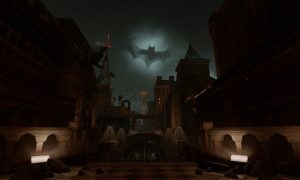 They were all dead.
They were all dead.
The silence in the room was deafening. Up until now, a pulsating, rhythmic beat in my head kept time as I rushed my way into room after room of this dilapidated hotel, like some coked-up demonic force. Everything was a blur, the rooms swaying, the colors — neon pink, blue, green, somehow all at once and not at all — pounding their way into my brain.
All that was left were the remnants of a bloodbath. Crimson washed over the plush, puke green carpeting and the peeling wallpaper. How long had I been standing here? Minutes? Hours? It’s hard to tell. Time has a funny way of creeping up on you, warping your own reality.
I remember flashes. The crushing blow of a sledgehammer into a delicate skull. The quick toss of a knife into the chest of an unsuspecting guard. Had I failed at some point? Had I met my own demise somewhere in that cacophony of rage and tumult? It doesn’t matter — if I had, I’d just keep pushing harder until victory and I met at the end.
Why had I come here? A voice on my answering machine told me to. Said there was a “mess” that needed “cleaning.” Well, that explains why I’m here, but why am I here? Why did I listen? Who is this person on the other end of the line? Why do they want me to kill all of these people?
And why do I enjoy it?
—–
 Coming out of nowhere back in late 2012, Hotline Miami became an overnight indie sensation. Its over-the-top, trial-and-error-based violent action gameplay, its cocaine-and-palm-tree-infused 1980s aesthetic (think Drive plus Scarface meets David Lynch and you’re halfway there), its soundtrack (my God, the soundtrack!) — all of these things resonated with gamers all over the world, myself included. As of February of this year, Hotline Miami has sold over 300,000 copies, making it one of the most successful indie games ever made — and that’s just on the PC. Dennaton Games have ported their smash indie hit to PS3 and Vita, and I’m happy to say that it loses very little in the translation.
Coming out of nowhere back in late 2012, Hotline Miami became an overnight indie sensation. Its over-the-top, trial-and-error-based violent action gameplay, its cocaine-and-palm-tree-infused 1980s aesthetic (think Drive plus Scarface meets David Lynch and you’re halfway there), its soundtrack (my God, the soundtrack!) — all of these things resonated with gamers all over the world, myself included. As of February of this year, Hotline Miami has sold over 300,000 copies, making it one of the most successful indie games ever made — and that’s just on the PC. Dennaton Games have ported their smash indie hit to PS3 and Vita, and I’m happy to say that it loses very little in the translation.
Imagine finding a hidden gem from the 8-bit NES era of games, one that was lost to time due to an outcry from angry parents, censors, and society at large. Imagine discovering that game at a local pawn shop, your eyes drawn to its 80s-tastic cover. You rush home to pop the cart in your system (blowing it first, of course), boot it up, and discover an ultraviolent top-down action game unlike any game you’ve played before.
All of this may sound a little weird and intimidating. And it is — it’s supposed to be. Even after finishing the game, most of it makes little sense (unless you’re able to piece together its fever dream of a narrative). But even so, plowing through each of the levels is oddly compelling, with each of the brutal (both in difficulty and violent overtones) levels rewarding you with just another slice of this insane nightmare. You’ll likely not make sense of everything without some sort of plot synopsis available to you afterward, but it’s worth seeing how far down this rabbit hole actually goes.
One cannot write a review of Hotline Miami without mentioning its soundtrack, and it is amazing. Songs range from driving, throbbing beats to off-kilter and disorientingly dream-like tracks, and each one perfectly fits into its place in the game. I’m not a huge fan of listening to video game music outside of the game I’m playing, but this is one I’ll regularly fire up when I’m working, driving, or just lounging around the house. To say it’s phenomenal is the biggest understatement of the year, and this game’s soundtrack is worth playing Hotline Miami on its own. Amazingly enough, the gameplay holds up just as well to its aesthetics.
Each of the nineteen levels follows a similar pattern: you’ll receive a phone call, directing you to go and “clean” (read: kill) various locations around Miami. You hop in your Delorean, don one of several animal masks (each one granting special abilities, like doors that kill people when they open or faster movement speed), and murder every single person in the building. You’ll start with a simple punch, but knocking out bad guys (and then crushing their skulls into the ground with a mashing of buttons) will reward you with additional means to defeat the lurking guards. Guns, knives, axes, katanas and the like are strewn about each level, and it takes a keen mind to see the right path through each level and properly take out every guard in the room with an ever increasing combo meter.

It’ll take more than just running up to guys and clubbing them or shooting them from a distance. You can throw every single weapon you find. Run out of bullets as a guy with a knife rushes at you? Throw your gun at him, knock him out, then finish him off while he’s on the ground. Unsuspecting guard around the corner? Hold down one of the shoulder buttons to lock onto him, then throw your knife at him. Being able to figure out the best way to clear out every single room is immensely satisfying — like the most sadistic puzzle game you’ll play.
Oh, and you’ll die. A lot. One hit kills in Hotline Miami, and that applies to you as well as your foes. Part of learning how to maneuver through each of the increasingly dangerous locales is to learn from your mistakes. Luckily, restarting each area is as simple as pressing a button — there aren’t any load times that break up the action. Die, restart. Die, restart. You’ll learn, adapt, and press on with each failure. It can get really frustrating when a guy just off screen kills you without any warning, but now you know that there’s someone over there. You’ll get him next time. Or the time after that.
And then, once you defeat the last guy in the room, everything goes quiet, the only sound a lowly buzz to keep you company as you walk your way back through the recent displays of violence you’ve wrought toward the exit. It’s such a jarring shift from thumping techno to contemplative, eerie quasi-silence, and it’s one of the most powerful feelings I’ve ever had to deal with in a video game. To go from cheering on your own hell-bent violent escapades to suddenly thinking on the consequences of your actions is not something most games try to even touch, and the simple shift in tone as soon as a stage has been cleared speaks volumes. This, coupled with the odd color scheme and the rough art design is purposefully designed to make you feel as ill at ease as possible. This isn’t a game for the faint of heart, but those that can stomach it will find something here not found anywhere else.
—–
Hotline Miami supported both the keyboard and mouse combo as well as the Xbox 360 controller on PC, and as someone who played mostly with a gamepad the first time through, I transitioned pretty easily to playing on a PlayStation 3 controller. Playing on a controller with analog sticks isn’t quite as accurate as using a mouse, but you’ll quickly adapt to its nuances. And because restarting is so quick and easy, there’s little punishment for a botched attempt outside of just giving it another shot.
PlayStation gamers also get a few unique features worth mentioning. A 27th mask is hidden early on in the game that turns everything black and white (except for the blood, of course). Leaderboards and trophies are also available, allowing competitive types a few more reasons to dive back into Hotline Miami’s neon-soaked landscape time and again.
The Vita Connection
Once again, Sony is proving the value of its handheld by including both PS3 and Vita copies with a single purchase. Plus, with the push of a button, you can easily sync save files between both console and handheld copies, allowing you to continue playing on the go.For the most part, Hotline Miami works perfectly on the Vita. The controls are nearly identical, and I dare say that the twin analog sticks are just a bit better on the Vita, as they have a smaller diameter and therefore allow for quicker rotation and response to oncoming threats.
It’s not entirely perfect, however. The real problem with the controls lies in how it handles scrolling the screen and locking on. On PS3, you can look past your current field of vision by holding down one of the shoulder buttons, then pressing the other shoulder button to lock on to a particular victim. This way you can set up elaborate combos and prepare for offscreen foes in this way, and it works pretty well. On Vita, however, you have to use the touch screen to both shift the field of view, and lock onto enemies. This is less than ideal, especially in the middle of a tense firefight.
Even so, you’ll be able to get through every single level on either the PS3 or the Vita as long as you keep trying and adapt to each systems particular strengths and weaknesses.

Any complaints are minor compared to how amazing the rest of the game is. Its brilliantly twisted plot and aesthetics couple perfectly with its compellingly twitch-based, almost puzzle-like action. It’s not for everyone (even one of our own editors described it as “barf-tastic” at one point) but if you let its hooks into you, you will discover one of the most addictive, rewarding, crazy-ass games of recent memory. If you didn’t pick it up on PC, and you own either a PlayStation 3 or Vita, you literally have no excuse to not grab this retro-fueled atrocity simulator.
And seriously. That soundtrack.
I've been gaming since my dad made the bad decision of buying me a Nintendo when I was four years old. Every day I'd find myself with my face glued to a TV screen, punching away at buttons, getting furious with Bowser, Dr. Wily, and those freakin' birds in Ninja Gaiden. Since then I have failed to get my parents to play any board game with me, I sold my full copy of Earthbound with box and guide for $300 to some dude in Austria for rent money, and I still believe in Nintendo even after all these years.

See below for our list of partners and affiliates:

























